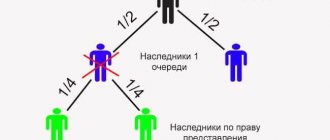The concept of separation from common shared property
Co-owner under Art. 252 of the Civil Code of the Russian Federation has the right to allocate the share that belongs to him .
As a result, a memory is formed. But the original property from which the plots are allocated does not lose its legal existence. The site remains within the changed boundaries, since part of the territory was alienated from it.
When planning an event, a co-owner must understand its feasibility. Most co-owners want to have a share at their personal disposal without coordinating transactions with other co-owners. In practice, separation occurs when there is disagreement between them.
If there are more than two co-owners, the allocation of a share is inevitable . The co-owner is given sole ownership of a part of the house, non-residential buildings according to the size and value of his share. But the allocation will occur if the event does not affect the purpose of the premises, a share of which is planned to be allocated.
In case of disproportionate damage to the premises, the allocation does not take place according to the law. The concept of “disproportionate damage” refers to the deterioration of the technical condition of residential premises, the conversion of residential premises to non-residential purposes, the alienation of premises that do not fall under the category of residential premises due to insufficient space or the inability to use the property.
Differences from section
The division is made in relation to any real estate: apartments, land plots . The main regulatory legal act regulating the procedure for dividing plots of land is the Land Code of the Russian Federation. A division by legal nature gives rise to the formation of one or several sections that have an independent legal destiny.
In addition, N218-FZ establishes the requirements accompanying the division of land. State registration of rights is carried out in relation to all land plots created as a result of the division.
The procedure for allocating a share of a land plot is established by N101-FZ of 2002. A part of it is separated from the common plot, which is in the mode of shared ownership. The original property remains, but its boundaries change.
Allocation and division have common grounds that lead to registration of the transfer of ownership:
- decision on division, consolidation of land plots of private owners;
- agreement with a similar description.
Articles of the Land Code of the Russian Federation, in particular 11.4 and 11.2, state that the original real estate object ends its legal existence from the moment of state registration of the transfer of rights to newly created land plots.
Are minimum sizes of land plots established by law?
It should be noted that the division and allocation of land is not always possible. An important condition of the section is the requirement for a minimum standard for the provision of land plots for the appropriate purpose. The minimum sizes of land plots for private household plots (personal subsidiary plots) and individual housing construction (individual housing construction) are determined by the relevant local authorities. The minimum sizes of plots for peasant (farm) households, horticulture, truck farming, livestock farming and dacha construction are established by the constituent entities of the Russian Federation. Currently, the minimum plot size for individual housing construction in the city of Yekaterinburg is 400 square meters (0.04 hectares).
This category of disputes is characterized by great difficulties due to the involvement of an expert and possible additional problems with real estate on the site. To save time and money, we recommend seeking help from a lawyer or lawyer in land disputes. You can contact us by phone or directly on our website. We provide paid legal consultations and provide legal services for representation in court in the city of Yekaterinburg and other regions. Online legal consultation - the consultant is provided free of charge. We will represent your interests in court or recommend an experienced, reliable, qualified lawyer or lawyer competent in a particular dispute.
Cases when allocation of a share of memory occurs
None of the co-owners can demand the allocation of the share of another co-owner from the common property.
The allocation of a share is the right of a co-owner, but not his obligation. This principle is based on several components:
- co-owners cannot be deprived or limited in the right of allotment;
- the allocation occurs solely at the request of the co-owner; the law does not impose mandatory requirements on the co-owner regarding the allocation of a share.
The law cannot deprive a co-owner of the right to his share. Provided that the other co-owner requests this when paying compensation. This provision follows from judicial practice (determination of the Supreme Court of the Russian Federation dated 02/07/2008, under N242-OO). The position of the RF Supreme Court establishes the impossibility of applying mandatory norms in this matter, as well as the provisions set out in judicial practice.
The law cannot help with the issue of allocation and payment of compensation, since imperativeness is not provided for in this matter. However, it establishes several allocation options under which compensation payments can be made in cash equivalent. We are talking about a forced method of allotment if the co-owners have not agreed among themselves and need the assistance of the court.
There are claims between heirs or ex-husband and wife regarding the share of each of them. The court considers them on the following grounds:
- The co-owner's share does not have title documents.
- The size of the share is indicated incorrectly in the documents.
- Disagreement with the actions of the co-owners of the land plot.
- Interference caused to co-owners by the local administration.
But these grounds apply in cases where disputes relate to property and are not related to the process of allocating a share in kind.
Methods for dividing land
The determination of the shares of former spouses may be based on:
- on the agreement between them;
- on a court decision.
An agreement on the division of a land plot is drawn up by the spouses independently or with the help of a lawyer. The law does not impose strict requirements on the form - simply recording the conditions in writing will be enough, but if the spouses wish, they can have the document certified by a notary.
The spouses determine the conditions independently: they can choose any option for dividing the property with the only condition - the division option they choose must comply with the law. In addition, according to a marriage contract, it is impossible to completely deprive the second spouse of property - such a document with such enslaving conditions can be challenged in court.
If the spouses have not reached an agreement on the division of land, the only option left is judicial procedure.
How the plot will be divided during a divorce in court:
- if there is a marriage contract, then the judge will rely primarily on its content;
- in the absence of a marriage contract, the shares of the spouses are equal. However, the court may deviate from equality of shares based on the interests of the spouses themselves and their minor children.
In the latter case, the judge’s decision may be influenced by such circumstances as serious illness and inability to earn income, children living with their spouse, etc.
The issue of dividing a privatized land plot allocated for the purpose of individual housing construction, on which a building has already been built, deserves special attention. There are several options available here, all of them are presented in the table below.
| Land acquisition | Land privatization | Construction, acquisition of a building | Section of the plot | Building section |
| before marriage registration | before marriage registration | married | impossible | possible if the building was built using the common funds of the spouses |
| married | married | married | available | available |
| before marriage | married | before marriage | impossible | impossible |
| before marriage | married | married, but before the privatization of the plot | possible if the value of the land has increased due to the common funds of the spouses or the labor of the second spouse | available |
| before marriage | married | married after privatization of the plot | impossible | possible, while the spouse who has a share in the building has the right to use the site to access the building |
Conditions
Art. 11.5 of the Land Code of the Russian Federation establishes that when allocating land plots, a new or several plots are formed. The original object remains within the modified boundaries. The basis for allocating a part from the whole land plot is an application for allotment, which is drawn up on behalf of the interested person.
The document is drawn up in any form indicating the following information:
- details of the owner of part of the land plot;
- the essence of the problem, petition, request;
- grounds for allocation (the applicant provides references from laws);
- legal status of the land plot, preservation of its purpose during further use in accordance with the VRI.
The application is signed by the interested person.
Order
A co-owner interested in going through the procedure enters into an agreement with the other co-owners. In it, they are not opposed to contacting a specialized company engaged in geodetic work. The companies are private, they charge for services, the main thing is that they have permission for this type of activity.
Next, the event goes through a number of stages:
- A cadastral engineer and surveyors come to the site. They take photographs, mark the boundaries of the lobe, and clarify them. As a result, a boundary plan is drawn up, which is part of the boundary work.
- The citizen draws up a new package of documents, submits them and the boundary plan to two organizations to choose from: MFC or Rosreestr.
- Hands over documents. Waits for some time: approximately 10 days. Afterwards, he receives an extract from the Unified State Register of Real Estate for a new property.
The co-owner must pay special attention to the documents included in the list of documents submitted to Rosreestr. If one of them is missing, the transfer of ownership of the share will not be registered.
The set of required documents includes the following:
title-establishing: gift agreement, purchase and sale, inheritance documents;- documents for a share in the land plot (land survey plan);
- documented consent of co-owners to the allocation;
- passport of the interested person;
- application for allotment of shares.
The list of documents is not exhaustive, but approximate. Depending on the specific circumstances, local authorities on whose territory the land plot is located have the right to request other documents in addition.
Standards
In Art. 1182 of the Civil Code states that if the allocated share is less than the permissible size of the area, its allocation is impossible. Russian regions may have different standards.
If we take into account the average indicator, then the standards for the minimum size of storage area are as follows:
| Purpose | Number of acres |
| for gardening, gardening | at least 4 |
| country house construction | 6 acres |
| management of farm management | 15 acres |
| Private household plots | 10 acres |
If the newly created plot of land does not cover the area, the allocation is impossible. The alternative is payment of compensation.
The division of a land plot is understood as a set of measures as a result of which two or more land plots are formed from one land plot. A land plot can be divided on the basis of an agreement on the division of a land plot with the consent of all its owners or by a court decision.
The newly formed plots must meet the requirements established by the legislation of the Russian Federation, in particular the requirement on the maximum size of the land plot.
The maximum (maximum and minimum) sizes of land plots are determined by town planning regulations or land legislation (in relation to plots to which town planning regulations do not apply).
To divide a land plot, we recommend following the following algorithm.
1. Carry out cadastral work to survey the land plot
Conclude a contract for cadastral work with a cadastral engineer (IP) who is a member of a self-regulatory organization of cadastral engineers, or with an organization that has a cadastral engineer on staff.
The boundaries of a land plot are established in the presence, in particular, of the owners, possessors or users of the demarcated and adjacent land plots. Instead, their representatives may be present during the land survey by proxy.
The cadastral engineer will establish the boundaries of the resulting land plots and draw up a boundary plan.
The boundary plan may be placed for temporary storage in an electronic storage facility maintained by the rights registration authority.
2. Draw up an agreement on the division of the plot or obtain a court decision on the division of the plot
The agreement is drawn up in simple written form and signed by all owners of the divided land plot. At your request, the agreement can be certified by a notary.
The agreement provides the address and cadastral number of the divided land plot, information about its owners. It is indicated that the owners of the plot have decided to divide it, and it is described exactly how the division is made (for example, in proportion to the shares in the common property right).
If one or more owners of a land plot do not agree to enter into an agreement on its division, it will be necessary to apply to the magistrate or district court at the location of the plot with a claim for its division.
The jurisdiction of a case on the division of a land plot depends on its value: a claim on the division of a land plot worth 50,000 rubles. and less should be presented to the magistrate, in other cases - to the district court.
3. Assign addresses to newly created land plots
Apply for the assignment of separate addresses to newly formed land plots to the authorized local government body or government body of the constituent entities of the Russian Federation - cities of federal significance.
The application can be submitted in person or through a representative, sent by mail, transmitted through the MFC or sent in the form of an electronic document, including through the Unified portal of state and municipal services (functions), the regional portal of state and municipal services (functions) or the portal of the federal information address system through the Internet.
The decision to assign an address, as well as the decision to refuse such assignment, is made within no more than 18 working days from the date of receipt of the application.
4. Contact Rosreestr for cadastral registration and registration of ownership of the resulting plots
When dividing a land plot, state cadastral registration and state registration of rights to the formed land plots, as well as deregistration and termination of ownership of the original land plot are carried out simultaneously.
To register the right to the state cadastral register and state registration of the right, the following documents must be submitted:
1) identity document;
2) an application for state cadastral registration and state registration of rights to land plots;
3) decision on assignment of addresses;
4) an agreement of owners or a court decision on the division of a land plot;
5) a document confirming authority, if the application is submitted by a representative.
6) Land survey plan in electronic form. If the boundary plan is placed in electronic storage, its identifying number can be indicated in the application. In this case, the provision of a boundary plan will not be required.
A state fee must be paid for registering ownership of land plots. It is not necessary to submit proof of payment along with the application. The applicant has the right to do this on his own initiative. However, if there is no information about the payment of the state duty in the State Information System on state and municipal payments, after five days from the date of filing the application, Rosreestr will return the application and the documents attached to it without consideration.
The amount of state duty when registering ownership of a land plot depends on the category of land and the type of permitted use of the plot:
— 350 rub. - in relation to a plot intended for personal subsidiary farming, dacha farming, vegetable gardening, horticulture, individual garage or housing construction, as well as a plot with an equivalent type of permitted use or a plot from the category of agricultural land of other types of permitted use;
— 2,000 rub. - in other cases.
If it is possible to submit an application and pay the state fee through government services portals and other portals integrated with the Unified Automated Identification of Information System (USIA), the state fee is calculated with a coefficient of 0.7.
The application and necessary documents can be submitted to Rosreestr in one of the following ways:
- directly to the Rosreestr branch or through the MFC (regardless of the location of the property according to the list of divisions that carry out reception on an extraterritorial basis posted on the Rosreestr website) or to an authorized person of Rosreestr during on-site reception;
- by postal item with a declared value when forwarding it, a description of the contents and a notification of delivery (in this case, the authenticity of the signature on the application must be notarized, the agreement and power of attorney of the representative must be notarized, and copies of identification documents must be attached);
- in the form of electronic documents via the Internet, for example through the official website of Rosreestr.
If at the time of submission of the application the state duty has not been paid, the applicant is issued or sent information containing a unique payment identifier (unique accrual identifier) necessary to confirm the fact of payment for a specific service for payment of the state duty, indicating the date by which it must be paid.
You can pay the state fee for state registration, including through the MFC.
5. Receive documents after cadastral registration and state registration
Cadastral registration and state registration of land plots are carried out within 10 working days from the date Rosreestr receives the application and documents. If the application was submitted through the MFC, the processing time for the application will be 12 working days. This period begins on the next working day after the date of receipt of documents.
State registration and cadastral registration are certified by an extract from the Unified State Register of Real Estate, which can be sent to the applicant in electronic form.
How is the decision made?
New land plots are formed legally with the consent of tenants, mortgagees, and land users .
In case of disagreement - by court decision, regardless of the disagreement of the previously indicated subjects. This is stated by N101-FZ of 2002. A land plot is formed on the basis of a decision. The document is accepted by the co-owners at a general meeting, but on the condition that the citizens have approved the land surveying project, the list of new real estate objects, and their shares.
Coordination of the boundaries of the land plot and their location is not required, since there is a decision of the co-owners. If there is no solution, the owner of the land share is obliged to draw up an agreement with the cadastral engineer. The specialist is engaged in a land surveying project for the purpose of allocating a land share.
Unlike the first option, in Art. 6 N101-FZ of 2002 states that the boundaries of the formed plot of land are agreed upon with the remaining co-owners : the cadastral engineer expects a response from them within 30 days. If no objections are received, the boundary work project is automatically approved.
In addition, in the absence of a decision of the general meeting of participants in shared ownership, the person interested in the allocation of a share is obliged to publish information about the allocation of a land plot in the media (in local newspapers of the region where the allocation takes place).
Timing, cost of the procedure
The cost of geodetic work and cadastral engineer services depends on several factors:
- land area,
- its distance from the center,
- number of formed areas.
It is impossible to give an exact figure; it all depends on the specific region. The procedure takes from one to two months.
Only the amount of the state fee for registering the transfer of ownership is determined precisely. Size set art. 333.33 Tax Code of the Russian Federation. For citizens it is 2000 rubles.
The procedure for allocating shares from agricultural land
Absolutely all shareholders (or members of an agricultural partnership) have the right to dispose of their share of the land, including the opportunity to rent out a share. Also, any owner of a share can request its allocation. The general meeting of owners makes a decision on the allocation and determines the location of the future site. The minutes of the meeting in writing are handed over to the applicant. If the applicant is not satisfied with the proposed location of the plot, he can file a lawsuit.
According to the general rules, the size of the plot corresponds to the minimum parameters of the urban planning regulations. The allocated share retains the category of agricultural land. The new boundaries do not intersect with the boundaries of lands owned by the municipality. The site does not intersect with other plots and buildings and does not interfere with other users.
The allocation of land is necessarily accompanied by land surveying according to the presented project. Additional measures to coordinate boundaries are not necessary.
The actions during the allocation procedure can be presented step by step in the form of a specific algorithm:
- Shareholders, together with surveyors and tenants, are working to determine the boundaries of new plots.
- The cadastral engineer records the received data in the plan. Temporary signs are installed at the boundaries of areas.
- A new boundary plan is being drawn up.
- A recommendation is issued to register new plots and register them with the cadastral register.
- In the new boundary plan, the previous dimensions are adjusted.
- The ownership of the plots is being re-registered.
Forced, through court
The reasons for going to court are disagreement with co-owners . The co-owners do not agree to the alienation of the share and do not sign the land surveying act. The person interested in the allocation applies to the court for help in resolving the controversial issue.
An interested party whose interests have been violated applies to a court of general jurisdiction at the location of the property in relation to which the dispute arises.
Rules for drawing up a statement of claim
Comprehensive information about the rules and structure of writing a statement of claim to the court is given in Art.
131 Code of Civil Procedure of the Russian Federation. You can file a claim in person or online. In the latter case, the application is signed with a reinforced digital signature.
The claim is drawn up in triplicate if the applicant personally brings it to the court office:
- 1 – a copy is transferred to the defendant;
- 2 – remains with the court’s stamp of acceptance from the applicant;
- 3 – remains in court.
The materials and documents attached to the claim are also prepared in triplicate.
When drawing up a claim, you should rely on the rules if the document is formed without the participation of a lawyer:
- Volume – no more than three pages. The claim is written in simple and concise language. Slogans, obscene language, and intricate assessments will lead to the return of the claim back to the applicant to eliminate the deficiencies in the document. As well as typos and gross errors.
- An indication of violations of the applicant’s rights with examples of articles of law is mandatory. The claim is not drawn up without indicating the legal acts, their articles regulating the scope of legal relations in which the interests of the applicant are affected. Judges, in practice, deal with several cases simultaneously. They physically do not have time to search for certain legal norms in the large volume of Russian legislation. Similar requirements apply to the evidence that the plaintiff provides to the court. It is in his interests to ensure that there are as many of them as possible. They must confirm the fact of violation of rights and legitimate interests.
- Accurate and strict adherence to the details of the claim. They are indicated in Art. 131 Code of Civil Procedure of the Russian Federation.
Drawing up a claim is a serious test for a person who has no legal experience. To correctly draw up a claim, it is better to contact a lawyer.
Statement of claim for division of land between spouses
If it is not possible to resolve the dispute peacefully, you have to resort to the help of the court. Perhaps the main document in the legal process is the statement of claim. The outcome of the case depends on how competently the spouse approaches its preparation.
Important! The statement of claim is always addressed to the court of the district where the defendant lives. The rules for filing a claim at the location of real estate are not applicable in this case, as the Presidiums of various regional courts have repeatedly stated. The claim will be submitted to the district (city) court at the location of the land plot.
Contents of the claim
A statement of claim for division of a land plot, like any other claim, must contain:
- name of the court;
- the full name of the plaintiff, his address, information about his representative (if the case is being handled by a lawyer), contact information;
- the full name of the defendant, his address;
- requirements for division of property and its legal and factual basis: date of marriage and its dissolution, circumstances of acquisition of the plot, presence or absence of a division agreement, information about children, etc.;
- the cost of the claim (determined by the value of the property being valued based on the plaintiff’s share);
- request to the court for division of property, indicating the method of division and shares;
- list of attachments, signature and date.
Drawing up a claim for the division of jointly acquired property has its own nuances. Here are some tips:
- Describe in detail the land plot whose division you are asking for: indicate its area, cadastral number, location of boundaries with reference to the coordinates of characteristic points, category and permitted use of the land.
- Be sure to specify in the claim the time and method of acquiring the land, its cost, attach supporting documents (purchase and sale agreement, certificate of state registration of rights, extract from the Unified State Register, payment documents, etc.).
- Be especially careful when composing the “petition” part. Clearly formulate how you want to divide the plot and why, specify who will pay compensation and in what order, etc.
- If you believe that the plot is not subject to division, justify your position and propose a solution
Documentation
The following documents must be attached to the statement of claim:
- a copy of the plaintiff's passport;
- certificates of marriage, divorce, birth of children (child);
- evidence of the acquisition of a plot during the marriage (certificate of registration/divorce, certificate of state registration of rights to a plot, agreement on the acquisition/privatization of a plot, act of a state body on the allocation of land, etc.)
- evidence of the acquisition of the plot using general funds (bank statements, income certificates, copies of savings books, etc.);
- receipt of payment of the duty (in the original).
The claim is assessed by the state. duty, the amount of which depends on the cadastral or market value of the land plot. Its calculation is carried out according to the rules for determining the amount of duty for claims of a property nature, prescribed in Art. 333.19 Tax Code of the Russian Federation.
When drawing up a claim in accordance with the requirements of Art. 131-132 of the Code of Civil Procedure of the Russian Federation, the court accepts the document for proceedings and initiates a civil case. Otherwise, the document may be left without movement (or immediately returned), and the plaintiff will be given a deadline to bring the claim into compliance with the requirements of the Code of Civil Procedure of the Russian Federation. All deficiencies will be indicated by the judge in the ruling.
Sample claim for division of land
Below is a sample statement of claim for the division of a land plot. You can download it for editing and use for your own purposes using the link below.








